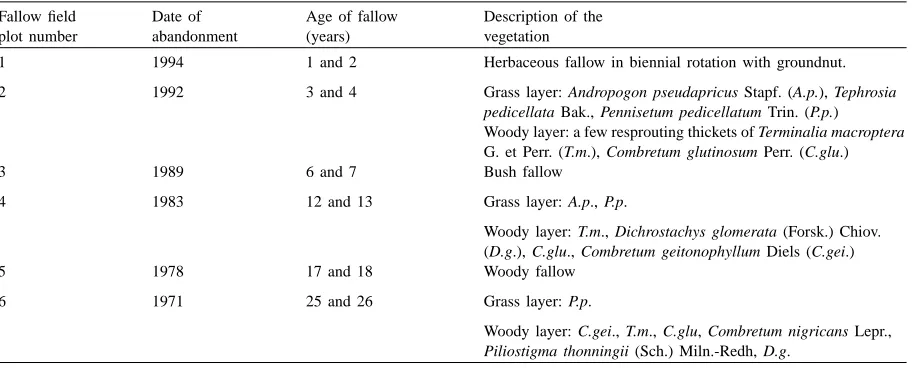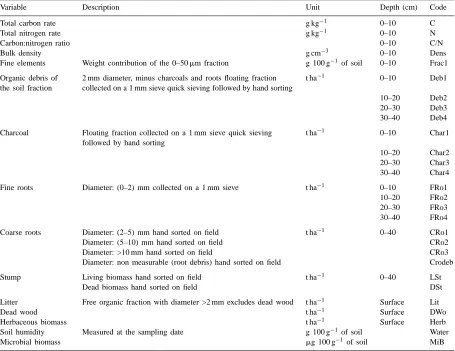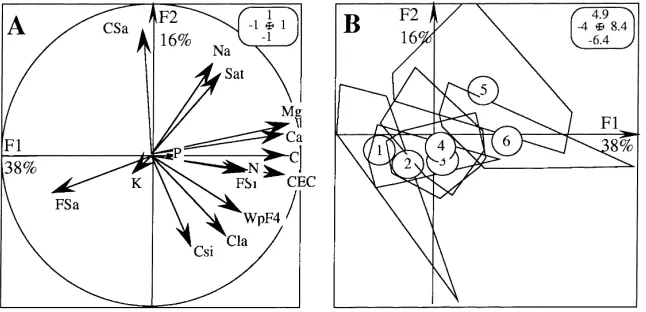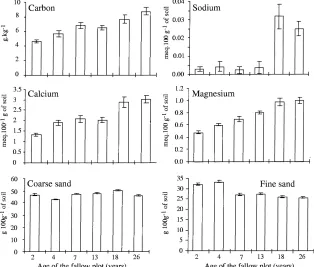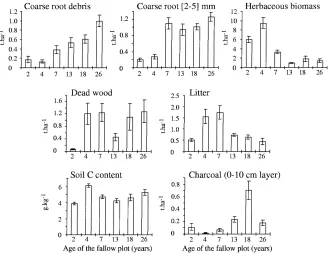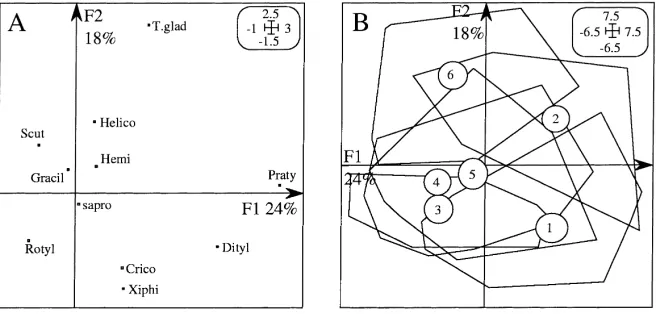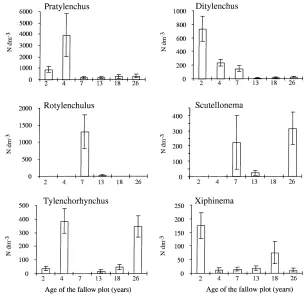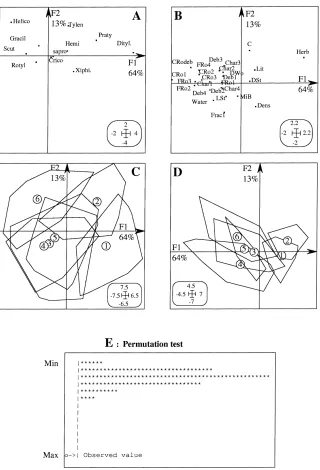Relationships between abiotic and biotic soil properties during fallow
periods in the sudanian zone of Senegal
Raphaël J. Manlay
a,1, Patrice Cadet
a, Jean Thioulouse
b,∗, Jean-Luc Chotte
a aInstitute for Research and Development (IRD, ex-ORSTOM), BP 1386, Dakar, SenegalbNational Center for Scientific Research (CNRS/UCB), Lyon 1, UMR 5558, 43 Boulevard du 11 Novembre 1918, 69622
Villeurbanne Cedex France
Received 8 June 1999; received in revised form 4 February 2000; accepted 9 February 2000
Abstract
Relationships between soil characteristics, various forms of soil organic matter, microbial biomass and the structure of phytoparasitic nematode populations were investigated in six fallow fields aged from 1 to 26 years in the West African Savanna (WAS) belt in southern Senegal. Soil sampling was performed along two transects in each field. Herbaceous biomass and soil physical, chemical and biological characteristics were studied with principal component analysis (PCA) and the relationships between the parameters were extracted with co-inertia analysis.
Soil properties (mainly calcium, magnesium and total carbon contents, and cation exchange capacity) slightly improved in the upper soil layer (0–5 cm) during the succession of vegetation. In constrast, in the 0–10 cm soil layer, microbial biomass and total soil organic carbon content showed no clear pattern of change over time, while highest charcoal stocks were found in older fallows where bush fires are frequent. In the 0–40 cm layer, living root biomass increased and herbaceous biomass decreased through the chronosequence. Evidence is presented here for particular relationships between some of the carbon components and the structure of the nematode community. Pratylenchus and Ditylenchus species were associated with the grass vegetation of the youngest fallows. In contrast Helicotylenchus and Scutellonema were present in old fallows. The multiplication of the latter appeared closely related to the presence of woody fine roots, whereas, that of the former seemed to be favoured by the presence of the coarsest roots of trees.
Xiphinema had a higher density in soils with higher bulk density. Microbial biomass was not affected by fallow duration
and was not correlated with the abundance of non-phytoparasitic nematodes. These results suggested that the management of crop pests such as nematodes in the soils of the WAS could be exerted through stump protection and tree plantation (improved fallow, agroforestry) during the crop-fallow cycle. © 2000 Elsevier Science B.V. All rights reserved.
Keywords: Co-inertia analysis; Fallow field; Nematodes; Organic matter; Soil abiotic factors; Sudanian area
∗Corresponding author. Tel.:
+33-4-7243-2756; fax:+33-4-7889-2719.
E-mail address: [email protected] (J. Thioulouse)
1Present address: Institute of Forestry, Agricultural and Envi-ronmental Engineering (ENGREF), BP 5093, 34033 Montpellier Cedex 1, France.
1. Introduction
Chemical fertility and physical stability of sandy soils in West Africa are low (Sanchez and Logan, 1992). Coarse texture, low activity clays, and harsh climatic conditions are the main reasons for nutrient leaching, erosion and low organic status of soils. Con-sequently, biota plays a crucial role in the fertility of
these soils (Chotte et al., 1995; Lavelle, 1997). Mech-anisms commonly put forward for the beneficial im-pact of biota on soil properties are the improvement of physical properties (aggregate stability and poros-ity) due to root dynamics, macrofaunal activity, and the conservation of nutrients in the plant biomass (Ab-badie et al., 1992).
In the West African Savanna (WAS) zone, the sus-tainability of farming systems relies very much on practices meant to promote biological activity and di-versity in soils. Fallowing and manure amendment are thought to be the most popular means. The latter aims at preserving the activity of soil biota, whereas fallowing stimulates the development of soil organ-ism communities, resulting in a more intense activity and a greater biological diversity (Feller et al., 1990; Pate, 1997). However, as a result of demographic pres-sure and local land tenure policy, fallows have nearly disappeared in the WAS (Ruthenberg, 1980; Floret et al., 1993). Therefore, traditional farming systems known for preserving soil health and quality have in fact shifted to ‘mining’ agriculture; their duration de-pends only on the depletion rates of assimilable nu-trients (Van Der Pol, 1992). Thus, alternatives for the improvement, or substitution of fallowing should take into account the traditional functions of fallow, such as biomass production and soil biological fertility en-hancement.
In this study fertility was defined as the ability of the whole below-ground ecosystem to enable steady plant productivity. The aim of our work was to de-scribe the process of fertility replenishment during the fallow period by investigating the interactions between living, functional groups (mainly roots, mi-croflora and nematode communities) and abiotic soil properties during the fallow period in the semi-arid zone of Senegal. We hypothesised that the sustain-ability of ecosystems of WAS relies largely on the relationships between the status of soil biota (fauna, mesofauna, micro-organisms) and soil carbon quan-tity and quality (Menaut et al., 1985; Perry et al., 1989; Lavelle, 1997). Therefore, this study focused on the relationships between:
• Root biomass and soil organic matter (SOM) con-tent. Roots are the main source of carbon to the soils in agro-ecosystems including those frequently ex-posed to fire, such as those encountered in the WAS (Menaut et al., 1985; Young, 1989)
• Nematodes, microbial biomass and SOM. The en-ergy required for the metabolism of heterotrophic organisms is contained in the SOM and also rep-resents the main source of nitrogen assimilable by plants. Carbon can be stored under biologically very active (living biomass) or more inert forms (litter, humus).
2. Methods
2.1. Field site
The study was conducted in the Region of Kolda, in Casamance, southern Senegal (12◦49′N–14◦53′W). The climate is dry tropical and rainfall occurs between June and October, averaging 960 mm per annum from 1978 to 1997. Mixed farming systems dominate. The main crops are millet, rice, sorghum, groundnut and cotton, and there is extensive management of livestock on rangeland. The soil was described as sandy, ferrug-inous by Baldensperger et al. (1967) and belongs to the order of Lixisols (FAO, 1998).
The up-slope plateau, on which slash-and-burn agri-culture is practised, is still covered with vast areas of ‘woodlands with a well developed tree stratum and shrubby undergrowth’ (DeWolf, 1998), savanna and old fallows. Resprouting Combretaceae (mostly Com-bretum geitonophyllum Diels, C. glutinosum Perr. and Terminalia macroptera G. et Perr.) are the major com-ponent of the woody vegetation. Bush fields at the edge of the plateau are devoted to the cropping of groundnut (Arachis hypogaea L.) mostly in short ro-tation with fallow, and sometime in biennial roro-tation with millet if manured.
2.2. Locations
Table 1
Description of the sampled plots
Fallow field
1 1994 1 and 2 Herbaceous fallow in biennial rotation with groundnut.
2 1992 3 and 4 Grass layer: Andropogon pseudapricus Stapf. (A.p.), Tephrosia
pedicellata Bak., Pennisetum pedicellatum Trin. (P.p.)
Woody layer: a few resprouting thickets of Terminalia macroptera G. et Perr. (T.m.), Combretum glutinosum Perr. (C.glu.)
3 1989 6 and 7 Bush fallow
4 1983 12 and 13 Grass layer: A.p., P.p.
Woody layer: T.m., Dichrostachys glomerata (Forsk.) Chiov. (D.g.), C.glu., Combretum geitonophyllum Diels (C.gei.)
5 1978 17 and 18 Woody fallow
6 1971 25 and 26 Grass layer: P.p.
Woody layer: C.gei., T.m., C.glu, Combretum nigricans Lepr.,
Piliostigma thonningii (Sch.) Miln.-Redh, D.g.
local enquiries among peasants and confirmed by ring counts of cross-sections of woody species.
2.3. Sampling schemes
In each plot, two representative transects (TA and TB) were laid out 1 m apart.
For TA, 16 cores, 1.5 m apart, were taken from the topsoil layer (0–5 cm) for chemical and textu-ral analysis. Each sample contained approximately 300 g of soil. For TB, 20 soil samples (each weigh-ing around 750 g), 1 m apart, were taken from the 0–10 cm layer for microbial biomass, carbon con-tent, and nematode analyses. Fine root biomass and charcoal stock were sampled from the same spot in 10 cm increments to 40 cm depth using a 5.6 cm diameter core auger. Herbaceous and litter biomass were measured from a 1×0.5 m rectangle. Within this area soil was removed to 40 cm depth and coarse roots and stumps recovered. A detailed description of the abbreviations of the variables can be found in Table 2.
Soils were sampled at the beginning of the dry sea-son. Subsamples for chemical analyses were air-dried, sieved to<2 mm and stored at room temperature prior
to analysis. Soils for biological determinations (micro-bial biomass and nematodes) were kept at field con-ditions and analysed the day after collection.
2.4. Analyses
All soil subsamples used for physical, chemical and biological analyses were individual samples taken from intact TA/TB cores; no composite was made from these cores.
2.4.1. Physical and chemical properties
Mineral particles of the clay (Cla), fine (Fsi) and coarse (Csi) silt, and fine (Fsa) and coarse (Csa) sand fractions were collected by mechanical analysis after the destruction of organic matter by hydrogen perox-ide and the total dispersion of 10 g of soil in a NH4Cl
Table 2
Variable codes for the ‘organic matter’ data
Variable Description Unit Depth (cm) Code
Total carbon rate g kg−1 0–10 C
Total nitrogen rate g kg−1 0–10 N
Carbon:nitrogen ratio 0–10 C/N
Bulk density g cm−3 0–10 Dens
Fine elements Weight contribution of the 0–50mm fraction g 100 g−1 of soil 0–10 Frac1
Organic debris of the soil fraction
2 mm diameter, minus charcoals and roots floating fraction collected on a 1 mm sieve quick sieving followed by hand sorting
t ha−1 0–10 Deb1
10–20 Deb2
20–30 Deb3
30–40 Deb4
Charcoal Floating fraction collected on a 1 mm sieve quick sieving followed by hand sorting
t ha−1 0–10 Char1
10–20 Char2 20–30 Char3 30–40 Char4
Fine roots Diameter: (0–2) mm collected on a 1 mm sieve t ha−1 0–10 FRo1
10–20 FRo2
20–30 FRo3
30–40 FRo4
Coarse roots Diameter: (2–5) mm hand sorted on field t ha−1 0–40 CRo1
Diameter: (5–10) mm hand sorted on field CRo2
Diameter: >10 mm hand sorted on field CRo3
Diameter: non measurable (root debris) hand sorted on field Crodeb
Stump Living biomass hand sorted on field t ha−1 0–40 LSt
Dead biomass hand sorted on field DSt
Litter Free organic fraction with diameter >2 mm excludes dead wood t ha−1 Surface Lit
Dead wood t ha−1 Surface DWo
Herbaceous biomass t ha−1 Surface Herb
Soil humidity Measured at the sampling date g 100 g−1 of soil Water
Microbial biomass mg 100 g−1 of soil MiB
2.4.2. Forms of organic matter
The litter collected at the surface comprised or-ganic debris free of mineral soil particles (sieved to >2 mm). It was manually separated into two frac-tions: dead wood (Dwo) and litter (Lit). Core sam-ples were elutriated under a water stream (Webb, 1995). The organic fraction collected on a 1 mm sieve was then separated by hand into three frac-tions: fine roots<2 mm (FRo), particles of charcoal
(Char) and organic residues (ORes). Coarse roots (>2 mm) (CRo) and stumps (dead and living) (DSt, LSt) were manually sorted in the field, washed and as for grass, litter and fine root biomass, oven-dried at 60◦C. Roots were classified into three diame-ter categories: 2–5, 5–10 and >10 mm (Cro1, Cro2
and Cro3, respectively), those which could not be so classified are referred to as root debris (Rdeb) (Table 2).
Soil samples were fractionated using a method adapted from Gavinelli et al. (1995) allowing the soil to be entirely dispersed without any alteration of or-ganic components. Soil was sieved to<50mm under
water and the fractions (0–50) and (50–2000) mm weighed.
2.4.3. Organic carbon and nitrogen
2.4.4. Microbial biomass
Microbial biomass of soil subsamples (equiva-lent to 50 g of oven-dried soil) was estimated by the fumigation–extraction method, using the gain in ninhydrin-reactive N after fumigation, multiplied by 21 (Amato and Ladd, 1988). The results were expressed asmg C 100 g−1soil (MiB) (see Table 2).
2.4.5. Nematodes
Nematodes were collected from soil samples (equivalent to 250 g oven-dried soil) by the Seinhorst’s method (Seinhorst, 1962). For phytoparasitic species, only those which were present in at least 5% of the soil samples, were used for statistics: Helicotylenchus dihystera (Helico), Scutellonema cavenessi (Scut), Rotylenchulus reniformis (Rotyl), Gracilacus parvula (Gracil), Criconemella curvata (Crico), Hemicyclio-phora belemnis (Hemi), Tylenchorhynchus gladiola-tus (Tylen), Xiphinema parasetariae (Xiphi), Praty-lenchus pseudopratensis (Praty), DityPraty-lenchus myce-liophagus. (Dity). Free-living species were pooled in a single group (Sapro). Results were expressed as individuals per dm3and transformed [log(x+1)] prior to analysis.
2.5. Statistics
Statistical analyses were performed on three data sets: (a) the pedological data, with 96 rows (six plots, with 16 sampling points per plot) and 15 columns (15 physical-chemical variables); (b) the soil organic and microbial biomass data, with 120 rows (six plots,
Fig. 1. PCA of soil properties of the 0–5 cm layer. (A) correlation circle of the variables; (B) factorial plan of the sampling spots.
with 20 sampling points per plot) and 28 columns (27 variables describing the organic matter, plus the microbial biomass); (c) the faunistic data, with 120 rows (six plots, with 20 sampling points per plot) and 11 columns (10 plant parasitic nematode species plus the free-living nematode group). Each table of data sets was analysed using Principal Component Analysis (PCA). PCA was based on a correlation matrix for the pedological and organic matter tables, and on a covari-ance matrix for the nematode table (since there is no reason to standardise the nematode species numbers). The relationships between the nematode table and the organic matter table were analysed with Co-inertia Analysis (Chessel and Mercier, 1993; Dolédec and Chessel, 1994). The permutation test was done by per-mutating the rows of one of the tables, and recom-puting the total inertia (sum of the variances of all variables) of the co-inertia analysis. The distribution of this criterion (total inertia) is then plotted as a his-togram for 1000 permutations and the observed value (not permutated) is placed on the histogram to eval-uate its position among the permutated values. Com-putations and graphical displays were performed with the ADE-4 software (Thioulouse et al., 1997).
3. Results
3.1. Trends in soil properties
Fig. 2. Plot means and standard errors for selected soil properties of the 0–5 cm layer.
co-ordinates on the first factor (F1). Only coarse sand (Csa), exchangeable potassium (K) and in particular, fine sand (Fsa) had negative co-ordinates. However, Factor 1 was not strictly a particle-size gradient but rather a global size factor causally related to or-ganic carbon (C), and nitrogen (N), cation exchange capacity (CEC), exchangeable calcium (Ca), and magnesium (Mg), water content (WpF4), clay (Cla), and fine silt (Fsi) particles, with all these variables being correlated and varying in the same manner. On the second factor (F2), the variables Csa, sodium (Na) and saturation percentage (Sat) had high pos-itive co-ordinates, in contrast to the fine particles (Cla, Fsi).
Fig. 1B shows the PCA factor map for the 96 sam-pling points, with convex hulls around the 16 points of each fallow age. These convex hulls are partly super-imposed, as a result of high soil spatial heterogeneity encountered at micro-local scale. Their centers (num-bers 1–6) are well separated and ordered along the first axis, from younger (negative co-ordinates) to older fallows (positive co-ordinates). Similarly, the means
of the variables C, N, CEC, Ca, Mg, PF4, Cla, and FSi increased with the age of fallows. Fig. 2 clearly shows such increases for C, Ca, and Mg, and the con-trasting, relative decrease for FSa. Points of Plots 5 and 6 (18 and 26 year-old fallow) had higher positive co-ordinates on F2 (Fig. 1B) due to high levels of Na (Fig. 2).
3.2. Analysis of the forms of soil organic matter and associated microbial biomass
Fig. 3. PCA of the organic matter status variables (A) factorial plan of the variables; (B) factorial map of samples grouped per age of fallow.
stumps, and dead wood, but the correlation with these variables remained weak (Fig. 3A).
On Fig. 3B, the convex hulls for the six fallow pe-riods are partly superimposed, particularly for the last three ages (13, 18 and 26 years), but the hull centers were broadly ordered along F1 from left to right. Mid-dle aged fallow plots (4 and 7 years) have negative
Fig. 4. Plot means and standard errors for selected variables related to organic matter status of plots (see Tables 1 and 2 for codes and units).
values on the F2 axis because the amounts of litter and carbon were higher in these fallows (Fig. 4).
Fig. 5. PCA of the nematological characteristics according to fallow age. (A) factorial plan of the variables; (B) factorial map of the samples grouped per fallow age (see Section 2.4.5 for names of species).
3.3. Analysis of nematode populations according to length of fallow
Fig. 5A shows the PCA on covariance matrix of the nematode table. Pratylenchus and Ditylenchus have positive co-ordinates on the F1 axis in contrast to Scutellonema and Rotylenchus, which have negative co-ordinates. On the F2 axis, Tylenchorhynchus has positive co-ordinate and Xiphinema and Criconemella negative ones. The convex hulls corresponding to the six fallow ages are superimposed (Fig. 5B). The youngest fallows had positive co-ordinates on F1, due to the presence of high populations of Pratylenchus and Ditylenchus, and low populations of Scutellonema and Rotylenchulus. The converse is true for older fal-lows. The younger and older fallows were opposed on the F2 axis, the younger had higher populations of Ditylenchus and Xiphinema and the older had higher populations of Tylenchorhynchus (Fig. 6).
3.4. Nematode — organic matter relationships
The factor maps of the co-inertia analysis between nematodes and the organic matter table (Fig. 7A) were very similar to those of the PCA (Fig. 5A). The first axis, F1, was defined by the biomass of roots with a diameter in the 2–5 mm range and the biomass of coarse root debris, as opposed to herbaceous biomass. On the second axis, soil carbon content was opposed to soil bulk density and to fine elements ((0–50)mm
fraction, Frac1). Litter was of less importance than in Fig. 3A.
In contrast, co-inertia analysis inverted axes 1 and 2 (Fig. 7B) as compared to those defined by the PCA performed on ‘organic matter’ data (Fig. 3A). This stresses several relationships: Scutellonema and He-licotylenchus were associated with fine and coarse roots, but Helicotylenchus was more associated with large diameter roots (found in old fallows) than Scutel-lonema, which had a strong negative correlation with the biomass of the herbaceous vegetation (Fig. 7A-B). Helicotylenchus also had a negative correlation with soil bulk density and fine elements. These correlations were weaker for Scutellonema.
In contrast, the presence of Ditylenchus, Praty-lenchus, and Tylenchorhynchus was associated with large herbaceous biomass found in young fallows (Fig. 7). The abundance of Xiphinema was related to high values of soil bulk density, mainly observed in the youngest fallow. No relationship could be es-tablished between microbial biomass and nematode populations.
4. Discussion
4.1. Physical-chemical characteristics in the topsoil layer (0–5 cm)
Fig. 6. Plot means and standard errors for some of the nematode genera (units: nematode dm−3of soil).
the 7 years-old fallows, all soils had a similar clay content (<10%, Fig. 1A). The absence of any
textu-ral heterogeneity between plots thus validates the syn-chronic sampling approach. This is especially impor-tant, because, except for climate, clay+fine silt tent of soil is the best predictor for organic matter con-tent of tropical soils with low-activity clay (Feller and Beare, 1997). Thus, the higher organic carbon content, CEC and exchangeable bases recorded here in the up-per (0–5 cm) soil layer of oldest fallows, as compared to those of the young fallows can be related to an in-crease in tree root biomass and larger litter inputs (Nye and Greenland, 1960; Floret et al., 1993). The control of soil organic matter over CEC and some cations such as calcium and magnesium (Fig. 1) has already been widely reported for this class of soil (Asadu et al., 1997). More unexpected was the small variation in the concentration of phosphorus and potassium through the chronosequence (Fig. 1A).
4.2. Below-ground organic status in the 0–10 and 0–40 cm layers
investiga-Fig. 7. Relationships between nematodes and organic matter status variables with the co-inertia analysis. (A) and (B): factorial maps of the nematode and environmental variables, respectively. (C) and (D): factorial plans of the sampling spots grouped according to fallow age; (E): permutation test (number of permutations: 1000; observed value: 36.68; Histogram: minimum=8.371, maximum=36.68. Number of simulations X<observed value: 1000 (frequency: 1.000E+00). Number of simulations X>=observed value: 0 (frequency: 0.000E+00).
tions with the help of such tools as carbon natural isotopic abundance measurement would be needed to confirm this hypothesis based on the findings of Mordelet et al. (1997) in a more humid savanna.
with higher wood biomass available for burning, thus indicating potentially significant withdraw of carbon from the ecosystem due to abiotic events. This may thus seriously restrict inputs of organic material to soil organic pools. However, the role played by fires in controlling organic matter content of soils of the WAS may not be so critical. In Mali for instance, Masse et al. (1997) recorded similar soil organic contents (SOC) in soil of young fallows whether or not protected from fires.
This study indicates that soil microbial biomass is dependent upon transient carbon pools such as litter, dead wood and soil organic matter, but this dependence is limited, or even non-existent with roots. Further-more, our results do not provide much evidence for a significant contribution of fine roots to soil organic car-bon content. Both observations concerning the absence of a close association between microbial biomass and roots with SOC are rather unexpected. Roots are in-deed often reported to be the main providers of car-bon to the subsoil of savannas experiencing regular fire (Nye and Greenland, 1960; Floret et al., 1993).
However, sampling was performed at the end of the rainy season, during which massive ‘grazing’ of soil carbon and microfloral biomass occurs as a result of favourable below-ground water conditions (Singh et al., 1989). Macrofaunal activity may also be put for-ward to explain high SOC turnover during the fallow period in the area. On our study site there was a three-fold increase in the density of macrofaunal pop-ulations within the first 10 years of fallow (Fall, 1998). Termites and ants are known to be the most efficient or-ganisms in reallocating SOM and increasing its avail-ability for mineralization. For instance, termites may channel up to 90% of the plant biomass net productiv-ity towards their mounds for the satisfaction of their own energy needs (Jones, 1990). As a result, even de-caying roots are quickly decomposed and only a small proportion of the carbon they contain may be sta-bilised in the soil. This was confirmed by an on-going mesh-bag experiment conducted in the study site indi-cating that at least 70% of woody roots may disappear within the first year of on-field incubation (Manlay, unpublished data). In so doing, soil macrofauna dis-rupts the functional continuity expected between both root and soil carbon pools.
Clearly, further sampling is needed to re-estimate the links between the main below-ground carbon pools
(SOC, root and microbial biomass) at the beginning of the rainy season and to investigate the impact of seasonality on our data. In addition, measurements on termite mounds need to be made in order to assess the real gain or loss of SOC experienced by the ecosystem after crop abandonment.
4.3. Relationships between nematodes and forms of soil organic matter
Soil microbial biomass did not affect the abundance of phytoparasitic and free living nematodes (Fig. 7), al-though the latter feed upon soil micro-organisms. This group includes also a small proportion of predatory, omnivorous and fungal feeding nematodes. The abun-dance of Helicotylenchus in the old fallow may have been driven by the presence of large roots favouring its development. In contrast, fine roots seemed to sup-port larger populations of Scutellonema, this species being observed in middle aged and oldest fallows. As the relation appeared only in the deeper layers, such roots might have originated from young trees but not from herbaceaous plants. In contrast, the abundance of Ditylenchus and Pratylenchus, which were associated with the herbaceous biomass, decreased when trees developed in more mature fallows.
increase the numbers of H. dihystera and to reduce the impact of phytoparasitic nematodes, enabling both crops and trees to coexist (Buresh and Tian, 1997). Host-parasite relationships, commonly very specific, should not impede the establishment of H. dihystera since it could multipliy on various hosts including the food crops commonly grown in this area (Siddiqi, 1992).
In this study, the presence of other nematode species was not related to food quality only. Unlike H. dihys-tera, Xiphinema seemed to be closely related to high top soil bulk density. This may explain the observa-tions of Harris (1975), who reports that this species is usually more abundant in deeper soils layers, where bulk density is higher than in the upper soil.
5. Conclusion
This study suggests that caution should be taken when describing fallow as a means for recovering soil chemical fertility. Its beneficial effect on chemi-cal characteristics of the topsoil (0–5 cm) undoubtedly rely on the biologically induced increase in the soil or-ganic carbon content. But the steady level of this prop-erty through the chronosequence as measured in the 0–10 cm layer indicates that the improvement of soil fertility in the entire layer exploited by plants relies on the displacement of biological rather than chemical equilibria.
This work introduces a new concept concerning the control of phytoparasitic nematodes. It is based on the relationships between the quality of below-ground organic matter (soil, fine or coarse roots, and het-erotrophic biota), and the abundance of phytoparasitic nematodes. Controlling the development of these plant parasites through the management of woody species is a feasible strategy, since coarse roots of trees clearly play a key role in maintaining nematode diversity. The clearing of fallow enhances the development of herba-ceous vegetation, and favours the multiplication of phytoparasitic nematodes species, that are frequently observed in cropped fields of this zone.
Although the mechanisms of this relationship are not well known yet, any strategy aimed at preventing the development of phytoparasitic nematodes should take into account the impact of trees on the soil biota, in order to select the most appropriate species.
Acknowledgements
This work received financial support from the Inter-institutional Inciting Action ORSTOM-CNRS-CIRAD-INRA ‘Bio-functioning of tropical soils and land sustainable management’, the EEC Project ‘Re-duction of the Fallow Length, Biodiversity and Sus-tainable Development in Central and West Africa’ (TS3-CT93-0220, DG12 HSMU) (Floret, 1998), the French Institute for Research and Development (IRD, ex-ORSTOM), the French Center for Scientific Re-search (CNRS) and the French Institute of Forestry, Agricultural and Environmental Engineering (EN-GREF). We acknowledge J. Fardoux and G. Ciornei for providing laboratory analyses.
References
Abbadie, L., Mariotti, A., Menaut, J.C., 1992. Independence of savanna grasses from soil organic matter for their nitrogen supply. Ecology 73, 608–613.
Amato, M., Ladd, J.N., 1988. Assay for microbial biomass based on ninhydrin-reactive nitrogen in extracts of fumigated soils. Soil Biol. Biochem. 20, 107–114.
Asadu, C.L.A., Diels, J., Vanlauwe, B., 1997. A comparison of the contributions of clay, silt, and organic matter to the effective CEC of soils of sub-Saharan Africa. Soil Sci. 162, 785–794. Baldensperger, J., Staimesse, J.P., Tobias, C., 1967. Notice
explicative de la carte pédologique du Sénégal au 1/200000 — Moyenne Casamance. ORSTOM, Dakar, 134 pp.
Bremner, J.M., 1965. Inorganic forms of nitrogen. In: Black, C.A. (Ed.), Methods of Soil Analysis, Vol. II. American Society of Agronomy, Inc., Madison, pp. 1179–1237.
Buresh, R.J., Tian, G., 1997. Soil improvement by trees in sub-Saharan Africa. Agrofor. Syst. 38, 51–76.
Cadet, P., Spaull, V.W., 1985. Studies on the relationship between nematodes and sugarcane in South and West Africa: Plant cane. Revue Nématol. 8, 131–142.
Chessel, D., Mercier, P., 1993. Couplage de triplets statistiques et liaison espèce-environnement. In: Lebreton, J.D., Asselain, D. (Eds.), Biométrie et Environnement, Masson, Paris, pp. 15–44. Chotte, J.L., Blanchart, E., Lavelle, P., 1995. Gestion durable des terres en milieu tropical. Régulation biologique des processus de décomposition de la matière organique. In: Ganry, F., Campbell, B. (Eds.), Sustainable Land Management in African Semi-arid and Subhumid Regions. Proceedings of the SCOPE Workshop, Dakar, Senegal, CIRAD, pp. 89–97.
Dabin, B., 1967. Application des dosages automatiques à l’analyse des sols, 3ème partie. Cahiers ORSTOM, Série Pédologie 5 257–286
Dolédec, S., Chessel, D., 1994. Co-inertia analysis: an alternative method for studying species–environment relationships. Freshwater Biol. 31, 277–294.
Donfack, P., Floret, C., Pontanier, R., 1995. Secondary succession in abandoned fields of dry tropical Northern Cameroon. J. Vegetation Sci. 6, 499–508.
Fall, S., 1998. Impact de deux espèces de termites à régime alimentaire différencié sur la matière organique et le compartiment microbien de termitières. MSc thesis, UCAD, Dakar, 86 pp.
FAO, 1998. World reference base for soil resources. World Soil Resources reports, Food and Agricultural Organisation, Rome, 98 pp.
Feller, C., Beare, M.H., 1997. Physical control of soil organic matter dynamics in the tropics. Geoderma 79, 69–116. Feller, C., Albrecht, A., Brossard, M., Chotte, J.L., Cadet, P.,
Hetier, J.M., Barrois, I., Mariotti, A., Castellanet, C., de Guiran, E., Clairon, M., Daly, P., Mahieu, M., Pilgrim, R., Ramdass, A., Ahmad, N., Griffith, S.M., Fardeau, J.C., 1990. Effets de différents systèmes de culture paysans sur quelques propriétés des sols et relations sol-plante dans la zone des Petites Antilles. Agriculture Paysanne et Développement: Cara¨ıbes-Amérique Tropicale-Guadeloupe 3, 163–191.
Floret, C. (Ed.), 1998. Raccourcissement du temps de jachère, biodiversité et développement durable en Afrique Centrale (Cameroun) et en Afrique de l’Ouest (Mali, Sénégal). Final Report, Comm. des Communautés européennes, Contrat TS3-CT93-0220 (DG 12 HSMU), IRD, Paris, 245 pp. Floret, C., Pontanier, R., Serpantié, G., 1993. La jachère en Afrique
tropicale. UNESCO, Paris, 86 pp.
Gavinelli, E., Feller, C., Larre-Larrouy, M.C., Bacye, B., Djegui, N., Nzila, J.d.D., 1995. A routine method to study soil organic matter by particle-size fractionation: example for tropical soils. Commun. Soil Sci. Plant Anal. 26, 1749–1760.
Harris, R.G.H., 1975. Studies of nematode populations in sugarcane soil profiles. Proceedings of the South African Sugar Technol. Association 75, 1–7.
Jones, J.A., 1990. Termites, soil fertility and carbon cycling in dry tropical Africa: a hypothesis. J. Trop. Ecol. 6, 291–305. Klute, A., 1986. Water retention: laboratory methods. In: Campbell,
G.S., Jackson, R.D., Mortland, M.M., Nielsen, D.R. Klute, A. (Eds.), Methods in Soil Analysis. Part 1. Physical and Mineralogical Methods. American Society of Agronomy, Inc., Soil Science Society of America, Inc., Madison, pp. 635–662. Lavelle, P., 1997. Faunal activities and soil processes: adaptive strategies that determine ecosystem function. In: Begon, M., Fitter, A.H. (Eds.), Advances in Ecological Research, Vol. 27. Academic Press, London, pp. 93–132.
Masse, D., Dembélé, F., Le Floc’h, E. et Yossi, H., 1997. Impact de la gestion des feux de brousse sur la qualité des sols des jachères de courtes durées dans les régions soudaniennes du Mali. In: Renard, G., Neef, A., Becker, K., von Oppen, M. (Eds.), Soil Fertility Management in West African Land Use Systems, Niamey, Niger, Margraf Verlag, pp. 115–121.
Menaut, J.C., Barbault, R., Lavelle, P., Lepage, M., 1985. African savannas: biological systems of humification and mineralization. In: Tothill, J.C., Mott, J.J. (Eds.) Ecology and Management of the World’s Savannas. Australian Academic Science, Canberra, pp. 14–33.
Mordelet, P., Menaut, J.C., Mariotti, A., 1997. Tree and grass rooting patterns in an African humid savanna. J. Vegetation Sci. 8, 65–70.
Nye, P.H., Greenland, D.J., 1960. The Soil Under Shifting Cultivation. Technical Communications, CAB, Farnham Royal, 156 pp.
Page, A., Miller, R., Keeney, D. (Eds.), 1989. Methods of Soil Analysis. Part 2. Chemical and Microbiological Properties, Vol. 9. Madison, WI, 1159 pp.
Pate, E., 1997. Analyse spatio-temporelle des peuplements de nématodes phytoparasites dans les systèmes de culture à jachère du Sénégal. PhD Thesis, Université Claude Bernard, Lyon 1, 208 pp.
Perry, D.A., Amaranthus, M.P., Borchers, J.G., Borchers, S.L., Brainerd, R.E., 1989. Bootstrapping in ecosystems. Bioscience 39, 230–237.
Ruthenberg, H., 1980. Farming Systems in the Tropics, 3rd Edition. Oxford Science, Oxford, 424 pp.
Sanchez, P.A., 1987. Soil productivity and sustainability in Agroforestry systems. In: Steppler, H.A., Nair, P.K.R. (Eds.), Agroforestry: a decade of development. International Council for Research in Agroforestry, Nairobi, pp. 205–223.
Sanchez, P.A., Logan, T.J., 1992. Myths and science about the chemistry and fertility of soils in the Tropics. In Lal, R., Sanchez, P.A. (Eds.), Myths and Science of Soils of the Tropics. Soil Science Society of America, Madison, pp. 35–46.
Seinhorst, J.W., 1962. Modifications of the elutriation method for extracting nematodes from soil. Nematologica 8, 117–128. Siddiqi, M.R., 1992. Helicotylenchus dihystera. CIH description
of Plant Parasitic Nematodes. CAB International, Wallingford, UK, Set 1, No. 9.
Singh, J.S., Raghubanshi, A.S., Singh, R.S., Srivastava, S.C., 1989. Microbial biomass acts as a source of plant nutrients in dry tropical forest and savanna. Nature 338, 499–500.
Thioulouse, J., Chessel, D., Dolédec, S., Olivier, J.M., 1997. ADE-4: a multivariate analysis and graphical display software. Stat. Comput. 7, 75–83.
Van Der Pol, F., 1992. Soil Mining. An Unseen Contributor to Farm Income in Southern Mali. Bulletin of the Royal Tropical Institute No. 325, KIT Press, 47 pp.
Villenave, C., Cadet, P., 1997. Interaction of Helicotylenchus
dihystera, Pratylenchus pseudopratensis, and Tylenchorhynchus gladiolatus on two plants from the sudano-sahelian zone of
West Africa. Nematropica 28, 31–39.
Webb, N., 1995. Installation Guide to the Root Washer Basic System. Delta-T Devices Ltd, Cambridge, 14 pp.
